Despite the fact that the budgets during his glory days at RKO were minuscule, Val Lewton has become an outstanding example of the movie producer as auteur, leaving a mark on his "B" horror movies of the mid-1940s that is more distinct than that of their various directors.
Lewton (1904-1951) was born Vladimir Ivan Leventon in Yalta, Russia, and came to the U.S. at the age of seven with his mother, who was a sister of actress Alla Nazimova. He enjoyed a rather lurid early career as a writer, working as a reporter known for totally fabricating at least one story, and as the author of pornography. He often used pseudonyms, one being the name that would stick: Val Lewton. He entered films in 1933 as an editorial assistant to producer David O. Selznick.
In 1942 Lewton was put in charge of a new unit at RKO that was to specialize in low-budget horror films. His first film under this arrangement, Cat People (1942), was directed by Jacques Tourneur and stars Simone Simon as a woman who takes on catlike qualities when aroused by jealousy. In a style that was to become defining and influential, Lewton refrained from showing the menace clearly and relied upon atmospheric photography, sound effects and music to convey a palpable sense of dread. Lewton, sometimes credited under the pseudonym Carlos Keith, also contributed to the movies' screenplays. - from Roger Fristoe, for Turner Classic Movies
Find out more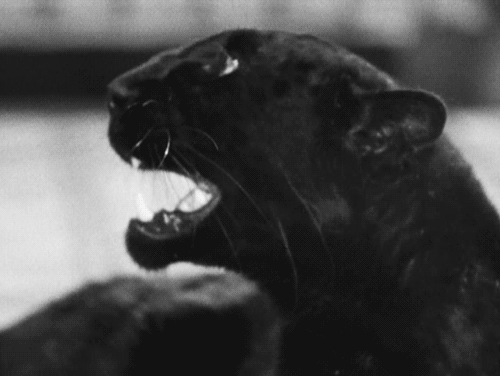
Val Lewton, Producer. Jacques Tourneur, Director. Val Lewton taught Hollywood how to scare people on a budget when he released Cat People, the first in his series of psychological horror films at RKO Studios, in 1942. After years of cheap thrillers dominated by hooded killers, men in gorilla suits, sliding panels and low-grade shocks, Lewton proved that intelligent films that made viewers imagine the worst rather than subjecting them to cheap fright effects could unnerve even the toughest audience.
With Cat People, Lewton established a formula for fear that he would exploit in later films like I Walked With a Zombie (1943) and The Body Snatcher (1945) (more lurid titles forced on him by Koerner). Lewton's films would start slowly in familiar surroundings while establishing the characters, then begin building a sense of dread and imminent danger. Then there would be a series of frightening scenes using suggestion rather than overt shocks but growing in intensity until the climax. And just to keep audiences jumping, the horrific scenes would climax with an unexpected jolt that usually signaled a return to normalcy. In Cat People, for example, the unseen Irena stalks her romantic rival through Central Park. Just as the cat seems about to attack, a bus pulls up, slamming on the brakes and opening its doors with a screeching sound that almost always sends audiences out of their seats. In honor of his first use of this gimmick, Lewton called such shocks "busses." - from Frank Miller, for Turner Classic Movies
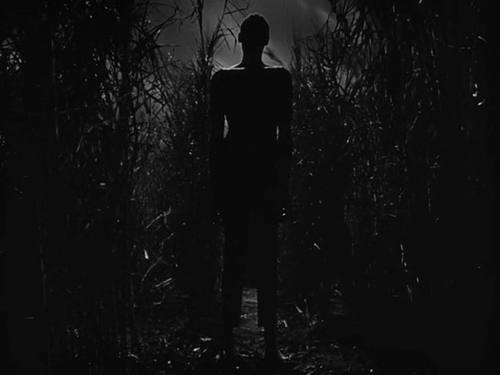
Val Lewton, Producer. Jacques Tourneur, Director. Betsy, a nurse from Canada, travels to an island in the West Indies to take care of Jessica Holland, a woman who appears to be the victim of some unexplained mental paralysis.
Visually elegant, I Walked With a Zombie (1943) is a very loose adaptation of Jane Eyre, transposed to a Caribbean setting. Ardel Wray, one of the screenwriters, recalls the preparation for I Walked With a Zombie in Val Lewton: The Reality of Terror by Joel E. Siegel: "We were all plunged into research on Haitian voodoo, every book on the subject Val could find. He was an addictive researcher, drawing out of it the overall feel, mood, and quality he wanted, as well as details for actual production. He got hold of a real calypso singer, Sir Lancelot he was called....He, in turn, found some genuine voodoo musicians. I remember they had a 'papa drum' and a 'mama drum,' that the crew on the set were fascinated by them, and by one particular scene in which a doll 'walks' in a voodoo ritual...I particularly remember that doll because Val sent me out to find and buy one 'cheap.' Everything had to be cheap because we really were on a shoestring. That was another thing about Val - a low budget was a challenge to him, a spur to inventiveness, and everyone around him caught the fever. Anyway, I got a rather bland-faced doll at a department store, cheap, and by the time she had been dressed in a soft gray robe, and her hair had been combed out to the appropriate 'lost girl' look, she too, was somehow transformed."
I Walked With a Zombie was said to be Val Lewton's personal favorite among his films, even though he despised the title. It was forced on him by RKO studio executive Charles Koerner who liked exploitive titles for purely commercial reasons. Nevertheless, the end result was anything but lurid and remains one of the most poetic films in the horror genre. - from Jeff Stafford, for Turner Classic Movies
Find out more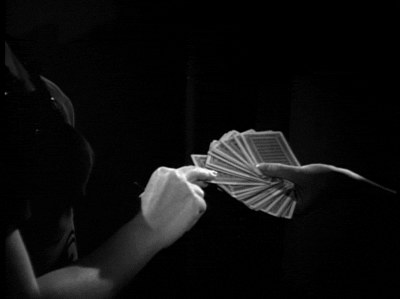
Val Lewton, Producer. Jacques Tourneur, Director. By the time of their third collaboration, producer Val Lewton and director Jacques Tourneur (pioneers of the psychological horror film) had solidly proven their theory that the unseen can be more frightening than the obvious. Rather than relying on elaborate makeup and special effects, films such as Cat People (1942) and I Walked with a Zombie (1943) situate their horrors in the dark shadows and the mounting paranoia that slowly engulf the films' characters.
The Leopard Man (1943) stars Dennis O'Keefe (T-Men, 1947) as Jerry Manning, a theatrical agent who convinces his songstress client Kiki (Jean Brooks) to incorporate a black leopard into her nightclub act. The publicity stunt backfires when the cat breaks free and later kills a girl in a New Mexico village. Soon thereafter, another woman (Tula Parma) is mysteriously killed while locked inside a cemetery, apparently mauled by the escaped cat. Manning, however, begins to suspect that the culprit is human rather than feline... a psychopath "with a kink in his brain," who is using the leopard as a sort of alibi. Meanwhile, Kiki's fellow performer Clo-Clo (Margo) is faced with omens of her own doom, and begins to wonder if perhaps she will be the Leopard Man's third victim.
Based on Cornell Woolrich's hard-boiled novel Black Alibi (1942), the screenplay was given a name change by RKO head Charles Koerner, who hoped The Leopard Man would capitalize on the popularity of Cat People, Lewton and Tourneur's first film together. Several of Woolrich's stories and novels were adapted to the screen by such filmmakers as Alfred Hitchcock (Rear Window, 1954), Mitchell Leisen (No Man of Her Own, 1950) and Francois Truffaut (The Bride Wore Black, 1968). But only Lewton and Tourneur succeeded in capturing the grim brutality of Woolrich's prose and the oppressive night that is such a vital ingredient of his work. - from Bret Wood, for Turner Classic Movies
Find out more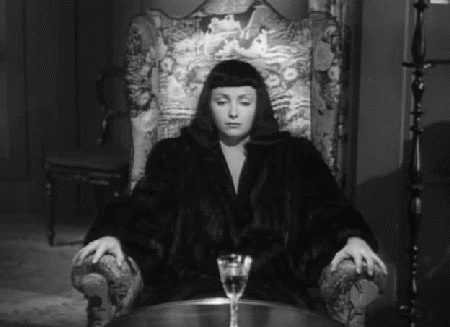
Val Lewton, Producer. Mark Robson, Director. Devil worshippers in Greenwich Village? Who would have thought? Actually, we wouldn't give it a second thought if we were talking about modern day New York but in 1943, the idea of Satanists thriving in such a quaint urban neighborhood was a rather novel and frightening prospect, something writer Ira Levin would exploit much later in his bestselling shocker, Rosemary's Baby.
In The Seventh Victim, Greenwich Village is a dark and foreboding place where despair, suicide, and death are a daily reality and a neighborhood cafe called Dante's doesn't seem at all out of place. Wandering into this maze of darkness is Mary Gibson (Kim Hunter), an orphan in search of her missing sister Jacqueline. When she discovers that Jacqueline was involved with a satanic cult called the Palladists, Mary turns to her sister's husband, Dr. Judd (Tom Conway) for help in locating Jacqueline.
After the success of Cat People, I Walked With a Zombie, and The Leopard Man, producer Val Lewton lost the services of Jacques Tourneur, the gifted director behind those influential thrillers. Tourneur was promoted at RKO and no longer affordable so Lewton turned to film editor Mark Robson to direct The Seventh Victim as his debut feature under Lewton's close supervision. (Robson would go on to direct four more pictures for Lewton). The result was Lewton's most personal film which expressed some of his own fears and incorporated some of his favorite literary interests such as the poetry of John Donne: "I run to Death, and Death meets me as fast, and all my Pleasures are like Yesterdays." The film was also the film debut of Kim Hunter (She had just changed her name from Janet Cole) and featured Chef Milani, well-known at the time for his bottled salad dressings, in a small role as a Italian chef. - from Jeff Stafford, for Turner Classic Movies
Find out more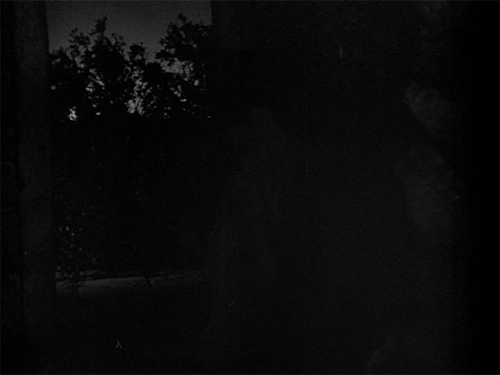
Val Lewton, Producer. Mark Robson, Director. Some of the finest of the RKO entries were under the guidance of producer Val Lewton, whose unit at the studio turned out eerie and atmospheric thrillers that depended more on dark and moody camera work and chilling suggestion than on monsters and gore. Lewton's low-budget films have become classics Cat People (1942), I Walked with a Zombie (1943) and launched the careers of many directors who went on to extensive work beyond the genre, notably Robert Wise, whose blockbuster Julie Andrews musical The Sound of Music (1965), was a horror only to some viewers. Also in 1945, RKO turned out A Game of Death (a loose remake of The Most Dangerous Game, 1932) and the superb adaptation of Robert Lewis Stevenson's short story The Body Snatcher, under the direction of Wise.
The tone of the film, and the set piece in particular, is maintained by the gliding camera of Jack MacKenzie under the direction of Mark Robson, who began his career in the Lewton unit. Robson's first film was the spooky The Seventh Victim (1943). Isle of the Dead proved so successful, he was paired with Karloff again for Bedlam (1946), set in a madhouse and inspired by a plate in Hogarth's series of paintings, "The Rake's Progress." Isle of the Dead was also inspired by a painting, the eponymous 1880 work by Arnold Boeklin, depicting a boatman ferrying a shrouded figure to the afterlife. The reference gives some sense of the artistic and literary sources the Lewton unit used to create its macabre films. - from Rob Nixon, for Turner Classic Movies
Find out more